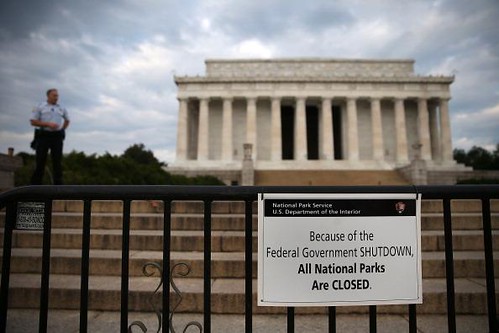Federal shutdown as another example of why local jurisdictions should have more robust contingency and master planning processes
 Getty Images photo of the Lincoln Memorial in Washington, DC.
Getty Images photo of the Lincoln Memorial in Washington, DC.The recession's impact on state parks--many states closed parks or considered doing so--plus the ongoing issue of how most parks in DC are run by the National Park Service, made me realize that local parks master planning should reference and address county, state, and federal parks (and related installations, such as national forests, run by the USDA, or Wildlife Refuges, run by a different division of the Department of Interior) within their jurisdictions.
I say this is important for two reasons: (1) local citizen interest is usually underrepresented in plans by non-jurisdictional agencies and local jurisdictions are tasked with representing that interest; and (2) to be prepared if situations change. See "Lies, damn lies, and statistics: parks edition."
After the crash, many state parks were shuttered, which was damaging in varying degrees to local tourism planning and the local economy. State and federal parks contribute significantly to local economies.
A 2008 estimate of the economic impact of National Parks concluded that each visitor spends about $4 for every $1 of federal money spent on the park, within 50 miles of the park.
So of course, now that the federal government is shut down, most places that are reliant on tourism associated with federal parks are getting battered economically.
Shockingly, the Department of Interior is allowing states to pay for the National Park Service to reopen and operate federal parks during the shutdown. The State of Utah is the first to take them up on the opportunity. See "Utah to pay federal government to reopen national parks" from Reuters and "Utah's national parks will reopen despite ongoing government shutdown" from CNN.
From the Reuters article:
The western state will pay up to $1.67 million to the federal government to allow visitors to return to its five national parks, the Cedar Breaks and Natural Bridges national monuments, and the Glen Canyon National Recreation Area, Utah Governor Gary Herbert said late Thursday.I wish Pennsylvania were similarly inclined, since we have a longstanding reservation to go to Gettysburg next weekend, this year being the 150th anniversary of the 1863 Civil War battle.
The governor said the parks should be fully open by Saturday. The money would keep the parks open for up to 10 days, and the state could make additional payments to have them open longer.
Utah was among several states that appealed to Interior Secretary Sally Jewell with offers to fund staff in exchange for reopening some of the country's 401 national parks, and the department said on Thursday it was considering the requests.
Labels: building a local economy, comprehensive planning/Master Planning, cultural heritage/tourism, economic development, parks planning, tourism, urban design/placemaking



1 Comments:
A debt of gratitude is in order for your glorious posting! I very delighted in understanding it.
Post a Comment
<< Home